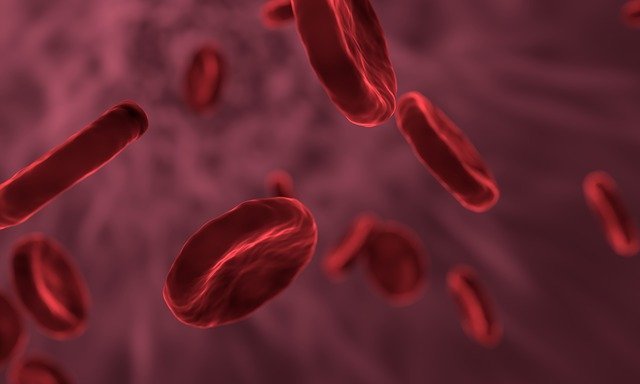
When the kidneys release an excessive amount of protein that promotes red blood cell growth, extra red blood cells are generated as well.
Red blood cells are responsible for transporting oxygen from the lungs to the cells of the body.
The presence of red blood cells in human blood has a variety of effects on the body and influences other parts of the cardiovascular system’s activity and function. Red blood cells contain hemoglobin, a protein that transports approximately 97 percent of total body oxygen.
The plasma also carries oxygen but in a far less efficient manner.
Studies have shown that an increased concentration of red blood cells can cause blood to thicken and makes it harder for the heart to pump while increasing arterial plaque formation.
If a person has too many red blood cells, it is called polycythemia.
This occurs when the bone marrow produces too many red blood cells. The extra red blood cells can cause the blood to become thicker and can lead to health problems.
The health problem with polycythemia
Some of the health problems that can occur with polycythemia include:
- Headaches
- Dizziness
- Shortness of breath
- Chest pain
- Bleeding problems
- Heart problems
- Stroke
Polycythemia can also increase the risk of blood clots. Blood clots can cause a number of serious problems, including heart attack, stroke, and pulmonary embolism.
What causes too much blood in the body?
There are many reasons why the body might produce too many red blood cells.
This condition is more common in men than women, and it also tends to develop with increasing age.
Some of the causes for too much red blood cell production include:
- Heart failure
- Lung cancer
- Chronic obstructive pulmonary disease (COPD)
- Anemia related to other medical conditions
- High altitude
- Smoking
- Bleeding disorders.
How is polycythemia diagnosed?
If you’re experiencing symptoms of too many red blood cells, your doctor will ask about your medical history and do a physical exam.
You may need any of the following tests to diagnose polycythemia:
- Blood tests to measure hemoglobin and hematocrit levels
- X-rays of your chest
- CT scan or MRI of your head
- Echocardiogram to check for heart problems
- Phlebotomy to remove a small amount of blood and check the number of red blood cells remaining in your body.
How is polycythemia treated?

The goal of treatment for polycythemia is to reduce the number of red blood cells in the body and restore normal blood flow. Treatments include:
- Phlebotomy
- Medications such as hydroxyurea, interferon-alpha, and darbepoetin alfa
- Surgery to remove the spleen (splenectomy) if the spleen is causing too many red blood cells to be produced
- Radiofrequency ablation to destroy the bone marrow that is producing too many red blood cells
- Procedures to open up blocked blood vessels
If you have polycythemia, it is important to seek medical care.
Treatment can help reduce the number of red blood cells and restore normal blood flow. Untreated polycythemia can lead to serious health problems.
Secondary polycythemia
Polycythemia can be a complication of other diseases or treatments and is treated differently than primary polycythemia. It is important to work with a healthcare provider to determine the best treatment plan for you.
- See also: What happens when your oxygen level drops too low
- See also: What happens if you take too much Melatonin?
What is the most common cause of secondary polycythemia?
Primary polycythemia is the most common cause of secondary polycythemia. It is usually caused by conditions such as:
- Heart disease
- Lung diseases, such as chronic obstructive pulmonary disorder (COPD) or asthma
- Thyroid problems
- Kidney disease
- Cancer and certain types of anemia
- Certain medications, including birth control pills, hormone replacement therapy, and chemotherapy drugs
If you have secondary polycythemia, it is important to work with your healthcare provider to determine the best treatment plan for you.
Treatment may include phlebotomy, medications, or surgery.
Untreated secondary polycythemia can lead to serious health problems.
As you can see, polycythemia is a serious condition that should not be taken lightly.
If you have any of the symptoms listed above, please seek medical care right away.
Treatment can help reduce the number of red blood cells and restore normal blood flow. Untreated polycythemia can lead to serious health problems
Can secondary polycythemia be cured?
Secondary polycythemia is treated differently than primary polycythemia.
It is important to work with a healthcare provider to determine the best treatment plan for you.
Treatment may include phlebotomy, medications, or surgery
Conclusion
As you can see, polycythemia is a complex condition that requires the help of a healthcare provider to treat. If you have any of the symptoms listed above, please seek medical care right away.
Treatment can help reduce the number of red blood cells and restore normal blood flow.
Untreated polycythemia can lead to serious health problems.
If you have secondary polycythemia, it is important to work with your healthcare provider to determine the best treatment plan for you. Treatment may include phlebotomy, medications, or surgery.
Untreated secondary polycythemia can lead to serious health problems.



